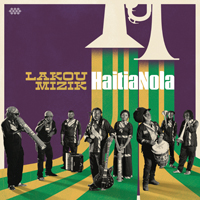
LAKOU MIZIK
HAITIANOLA (Cumbancha)
Lakou Mizik have called in a boatload of friends to help them celebrate the journey from Haiti to New Orleans on their second album. Both were French territories in the 18th century, and so the Crescent City saw an influx of Haitians after the revolution of 1791 left Haiti in turmoil. The band felt the connection when they were invited to play Jazz Fest in 2017 and were right at home. And there they met many acts, from Cyril Neville to Arcade Fire, who became their fans and were invited to participate in this project. To their simple line-up of acoustic guitar, congas and accordion they have added the mighty Preservation Hall Jazz Band plus another brass band the Soul Rebels. John Cleary's piano doesn't quite fit the voodoo-style percussion groove but the energy is good. Overall the inclusion of guests on nearly every track seems a bit desperate like they wanted to shore up their sound. However the silly Tank (of Tank and the Bangas) is so irritating that particular number has got to go! Nevertheless the tracks are short and mostly sweet. The highlight is "Iko Kreyol" another remake of "Iko Iko" which came out on an advance EP of four remixes.
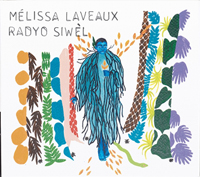
MELISSA LAVEAUX
RADYO SIWEL (No Format 40)
Melissa Laveaux is a Haitian born in Ottowa, Canada, hence her music is more reflective of her urbane upbringing and while it has French creole elements it doesn't include konpa, merengue, voudou jazz or other Haitian styles. Her backing musicians sound more like Lou Reed's (if the post-Velvets had practiced more), but her vocals are of the breathy Blossom Dearie type which makes it hard for me to get through the whole thing without taking a break. Sometimes you can't tell if she's singing in French or English, plus there's an intoxicated slurriness to her delivery which is not endearing. It makes me feel like a drunk on a merry-go-round. However the production on this, her latest (third) album is really excellent so it's easy to groove along for the ride and let the vocals slide. Laveaux first visited her parents' home of Cap Haitien two years ago; she started looking for folkloric music played by small bands of troubadours assembled for country festivals, known as bann' siwèl. Her research led her to explore the period between the two world wars when Haiti, the first free black country in the world, was occupied by the US, a century after declaring independence from France. The re-colonization led to the use of terror, in the form of manipulating people's fear of Voodoo gods to exert control and then of course through torture and murder by the Tontons Macoutes. Laveaux created a patchwork of old songs, leaning on the work of Dodo Titit and a Cuban expatriate Martha Jean-Claude whose lullabies she remembered from her childhood. Helped out by guitarist/tresero Drew Gonsalves of Kobo Town she give the rediscovered melodies new life. By examining the past Laveaux has given fresh form to the roots of Haitian music with a hip rock edge. The albums ends with a cover of "Panama mwen tombé" and then the band (mainly French Trinidadians) is introduced in a strange accent, giving a Bonzo Dog Band flashback to the outtro.
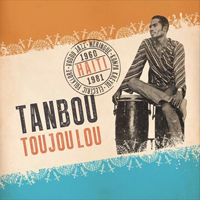
TANBOU TOUJOU LOU:
Meringue, Kompa Kreyol, Vodou Jazz & Electric Folklore From Haiti 1960-1981 (Ostinato Records)
Haiti always runs third behind the other big musical nags of the Caribbean: Cuba and Jamaica -- the latter became a global phenomenon in the 1970s, but Cuban music has long influenced its neighbors as well as spreading to North America and Mexico where cha cha, mambo, and salsa became huge in the last century. The influences on Haiti came the other way: from Cuba via the son as well as mambo and cha cha, Calypso from Trinidad, and from the US jazz was adapted and a craze for "mini jazz" found lots of bands with prominent horn sections, or interweaving clarinets and alto saxes (also heard in the Congo dance bands of the pre-independence era like Rock'a Mambo and Les Bantous). There is a debate as to whether the merengue is a native Haitian or Dominican rhythm since it is found in both halves of Hispaniola. One theory is it evolved from french contredanse, and the Haitian variety is sweeter and more nostalgic than the Dominican variety according to the liner notes of Haiti Chéri, a fine 1995 comp on the Corason label. I saw one of those "Hotel-folklore" groups in Haiti performing in costumes that came right out of the wardrobe for a light opera about Marie Antoinette. Merengue evolved into compas direct (or "Konpa") then into cadance ("Kadans") -- on the cover they called it "Meringue" which is a crunchy sweet made from egg whites. This new compilation casts a wide net and hauls in nineteen cuts of Haitian music, mostly what you would call Konpa, by many of the star acts, including Coupé Cloué, Tabou Combo, Les Gypsies de Pétionville, Les Loups Noir, Super Jazz de Jeunes, Nemours Jean-Baptiste, Webert Sicot, Shleu Shleu, etc. I have albums by all these artists and arguably could put together an equally engaging set, but that just shows you how consistent the music is. The advance material is promoting the compiler as an "Indiana Jones"-type hero crate-digging his way through Haiti, overcoming dust, bugs and scorn, as Samy Ben Redjeb has done in his musical forays into Africa. You can crate-dig Haitian music in New York (where Rotel Records put out loads of Haitian albums in the 70s), Paris, Washington DC, Miasmi [sic], in fact almost anywhere because lots of Haitians got the flock out of there when the Tonton Macoutes started leaving disembodied heads in the road in the 60s and 70s (the rich period covered by this compilation) and the expats brought their precious vinyl with them. Even the compiler admits, "most of the records were pressed for the U.S. market and Haitians in the diaspora, who could better afford them." But there are indeed discoveries here, and the new names are the most intriguing, from the accordion and drum opener "Lagen" by Zotobre to a couple in the middle by Super Choucoune 70 and Les Pachas du Canapé Vert. The notable Rodrigue Millien and Les Pachas du Canapé Vert were on the Strut double album that came out two years ago, Haiti Direct. The great Ibo Combo (who were also on that comp) turn in a storming track here, called "Souffrance," with two keyboards and speedy guitar licks. I am always glad to promote new Konpa compilations, and enjoy it greatly as I have fond memories of wild christmas holidays spent on the island of Hispaniola with my mad mzungu brother. The best Haiti comp for beginners that I know is Andy Kershaw's which came out on Rough Guide (RGNET1067) in 2001, but there's always room for more.

RAM
MANMAN M SE GINEN (Willibelle Publishing)
It's been a while since the last wave of trad-modern Haitian music washed up on our shores. I think it was Boukman Eksperyens who hit the world in 1990 but have not been heard from in the past decade. Or Boukan Ginen who were around briefly in the mid-90s. And of course Sweet Micky who hung up his rock n roll shoes to become president in 2011. One constant in Haitian music has been RAM, the house band at the Oloffson Hotel, another band in the roots style popularized by Boukman. The Oloffson Hotel is definitely a major reason to visit Port-au-Prince. It's where Graham Greene wrote (& set his 1966 novel) The Comedians and where cartoonist Charles Addams brought his various wives, every time he had a honeymoon to celebrate. It was a prime source of inspiration for the "Addams Family" cartoon which is set in a tottering on the brink of ruin Victorian Gothic mansion that strongly resembles the Oloffson. Since the 60s everyone from Anthony Bourdain to Kurt Vonnegut has dropped by and been enchanted by the spot. When you check in they hand you a coupon for a rum cocktail at the bar which is the heart of the building. The place is decorated with beaded rum bottles and Baron Samedi (a skeleton in top hat and formal wear) motifs. And since 1990 the house band has been RAM which features the hotel owner Richard A. Morse, along with his wife Lunise on vocals. They blend voudou in the form of rara horns and petwo drums (heard in the opening invocation) with rock n roll instruments for a rip-roaring good time. Manman m Se Ginen is the band's sixth album. Morse's mother was a folk artist and dancer in Haiti, and that's probably her invoked in the title (which translates as "Mother let die" -- but I am not sure what that implies!). They also turn in a cover of Coupé Cloué's "Jije'm Byen (Judging my assets)" in his classic sound with flanged guitar. RAM did not record for the last 12 years (the last 5 being the Michel Martelly era) which is odd, because you'd think that was because they had had previous brushes with authority and were afraid of getting arrested for their music, but President Martelly was not only a musician himself but a cousin of Morse. This is a well-crafted album and captures the excitement of a live concert with an African-like seben where the soloist kicks in at the mid-point of some songs, such as the classic soukous riffing of "Koulou Koulou" or "Ipokrit (manje bliye)." I love this language (Haitian kriyo): sound that out --"Mange oublier"-- it means "Hypocrite, forget food." They turn up the heat again for "M' pral Domi Nan Simitye (I'll sleep in the cemetery)" (dormir en cimetière, right?) which has hard rock grafted onto the rara horns. This must be a great end to their live show.
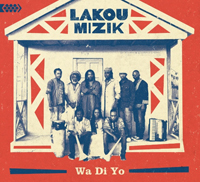
LAKOU MIZIK
WA DI YO (Cumbancha)
It is odd, after such a long silence (and years of desperation following the 2010 earthquake and cholera epidemic) to hear three new albums from Haiti. I am partial to this one because it was recorded in Jacmel, a lovely jewel pirate hideaway on the south coast where I spent a memorable Christmas in the sun and surf with my mad mzungu brother -- the adventurous one. It is also the scene of an annual "kanaval" captured in pictures by New York photographer Phyllis Galembo in her excellent book, Maske (Chris Boot, 2010). Lakou Mizik was formed after the earthquake to keep the music alive and united some veterans of the music scene with some youngsters. Sanba Zao, percussionist, is a living encyclopedia of traditional songs and rhythms; his son Woulele has risen to become a legendary session drummer; the rara horns are played by two cornetists, Ti Piti and James who each play a one-note horn but are so in tune they create melodies that could be coming from a trumpet or trombone; the bandleader Steeve Valcourt is the son of a famous Haitian musician who took him to Long Island but he returned to his homeland to fulfill his musical ambitions. It's the most traditional of the new releases, honing closely to the accordion-driven compas sound, which reminds me of a drunk carousel ride. Here there are songs about the "zònbis" you don't want to meet in the cemetery. They cover the traditional song "Panama mwen tombe" which tells of President Hyppolite whose hat fell off as he mounted his horse in March 1896. He ignored this bad omen and rode to Jacmel where his nemesis Jeannis, a powerful voudou priest, lived. En route the president had a heart attack and died. This is a beautifully realized album and goes out in fine style with the pensive title cuts, "Wa di yo: nou la toujou (Tell them, we are still here)."
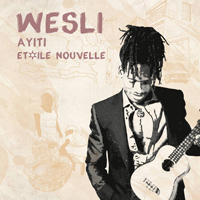
WESLI
AYITI ETOILE NOUVELLE (Wes Urban Productions)
This 2014 release has just turned up. It was recorded between Haiti and Montreal and features familiar compas rhythms as well as the underpinning of West African groove that gave rise to Voudou in the 18th and 19th centuries as Haiti freed itself from colonialism and struggled to survive as the poor neighbor in the largely white and Hispanic Caribbean. Roots music, known as "mizik rasin," can be played on many instruments. Here we hear accordion and agogo (West African iron bell -- also found in Brasil) but also jazz piano, a real string section and even West African kora and xylophone. There is also an influence from Jamaica -- not in a reggae beat, but in the lyric delivery of some songs like "Ça fait mal." But then Wesli spoils it by going all-out for a Bob Marley imitation in the singing of "La Vi Dwol." Wesli, called here the "New Haitian Star" has brought sophistication to the "rara" street carnival that is Haiti without losing his vital connection to it. On "Mama Africa" he sings in English and for once I am not cringing. He knows how to hit it and quit, so there is great variety here. "Sonje" would work on a Salif Keita album, with Spanish guitar and kora in harmony. Wesli has been spinning the global radio dial and this has had a beneficial effect, bring some interesting rhythms and arrangements to his set.
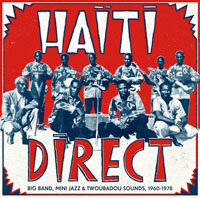
HAITI DIRECT
BIG BAND, MINI JAZZ & TWOUBADOU SOUNDS 1960-78 (Strut)
This came out on vinyl and CD a year ago. I wrote Strut for a review copy but they ignored me. It's a retrospective of early mini jazz ensembles and some of the big party bands that seemed to pour out of Haiti back in the days of Papa Doc Duvalier and his son Baby Doc. When I visited Haiti 15 years ago the place was falling apart at the seams and people longed for the bad old days: you had a glass of Babancourt rum and at least you knew the enemy, the Tonton Macoute, they said stoically. It was also the end of the era of the big bands who were being replaced by smaller groups with Miami Vice clothes and synthesizers and drum machines instead of horn lines and tumbadors. The Compas sound had been identified with Haiti as much as ska in Jamaica and local variations of salsa from Cuba, Puerto Rico and Colombia. Jean-Baptiste Nemours and Webert Sicot were the pioneers of the new big band sound, but as the 60s ticked over, smaller more dynamic groups brought rock guitars to the bandstand and created a denser, rawer, more earthy sound. Les Frères Dejean and Les Shleu Shleu were all the rage and their music quickly spread to North America also. When Tabou Combo rose to prominence they not only swept the Caribbean but the waves lapped to Europe and South America too. As they became more slick, adding mechanical toys to their set, the music morphed into Zouk by the mid-1980s. This compilation tells the story but also brings in lesser-known acts as well as artists influenced by the trovadors of Cuban music who became known as Twoubadou singers. The old Ra Ra music, which was a form of folk music, had all but disappeared, but "Gadé moune yo" collected here is a good example, with call and response vocals, vigorous percussion and some wild bleating that must be animal horns or trumpets made from roots. We do get some squinchy synth from Scorpio Universal at the end of disc one, but jump right back to the old-timey, almost 1930s sound of Raoul Guillaume with his group performing "Mal Elévé (Badly brought up)." The second disc starts out more laid back (in the olden time) and includes "Jouc li jou" by Pierre Blain which I had only known from a later stuttering zouk version by Tabou Combo. The clarinets and sax of the original make a nice ensemble. We also get to bask in the mellow grooves of Nemours Jean-Baptiste and Trio Select, the parents of the modern sound. One of my favorite early bands, Les Fantaisistes de Carrefour turn in a lovely number replete with laughing. It was not until I listened to this set that I noted the connection with the Peruvian Cumbias that were rediscovered and sprang into our consciousness in the last few years. So these are musical currents that run throughout the region. There was always an argument over whether the merengue came from Haiti or the next door Republica Dominicana, but there's a pan-Caribbean or if you prefer tropical beat that permeates this music. Even so I notice "Hotel California" creeping into the opening riff of "Jive Turkey" (1978) by Djet-X. Of the missing acts, like Les Gypsies de Petionville and Les Diables Bleus, I would certainly have included Coupé Cloué, but maybe Strut is planning a sequel.
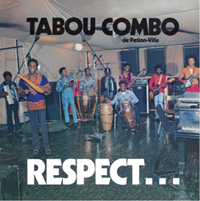
TABOU COMBO
RESPECT (Secret Stash)
This is a reissue of one of the great albums by arguably the best band to come out of Haiti. Formed in 1967 by guitarist Albert Chancy and drummer Herman Nau, they played their own version of Compas (or Konpa): electrified Haitian folk music, that created a whole new genre and was imitated by scores of other artists. Compas is a wheezy carnival ride like a sea shanty seven seas over. At first they used accordion which was replaced gradually by synthesizer. Two congueros and other percussion (cowbell, guiro) keep the beat while pulsing bass and soukous-like sinuous twining lead guitars push things along. They alternate speedy riffs with more French cafe-like ballads. But the signature sound is a quick plectrum-picked electric lead on reverb and a woozy momentum suggesting you have had one too many glasses of rum and better keep your eyes open. This staring into the glitterball creates immediate hypnosis and your brain waves give in to the psychedelic ride. But for all their innovation, Tabou Combo were not an immediate success, in fact after a few years of gigging they split up and went their separate ways, mostly to the USA, but they reformed in Brooklyn in 1971, where they incorporated a little funk and a little soul into their sound, and for the next four years toured Europe, Africa and the Caribbean, and recorded several albums, including this one in 1973 at their peak. The French ballads are corny and dated but help break up the juggernaut of their pop tunes which will wear you out dancing. I don't know how many original members are still with the band, which is going strong after 40 years (& they have a new album out in 2011), but I recognize Roger "Shoubou" Eugene, the vocalist from the old line-up. However this (short but sweet LP) is one of their classic albums from their first decade, before they added "Superstars" to their name and went all drum-machiney and synthi. A real gem.
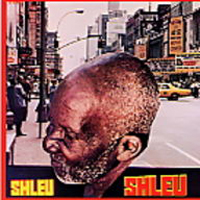
LES SHLEU-SHLEU
TETE CHAUVE (Mini Records MRSD1003 1990)
There's a merry-go-round quality to Compas, the pop music of Haiti. Accordions wheeze and bass guitars lope along in a two-step; clarinets and soprano saxes ebb & flow merrily on a tide of joie de vivre. Nowadays the big horn sections are becoming obsolete. There's still good drumming and vocals, but the synthesizer has taken over a lot of the duties of the once-large band. Lyrics extol "Haiti le paradis" maugre appearances to the contrary. I decided, in this sultry weather, to dust off my Haitian section. Now I am not sure what Viper Jazz is (I think it was something disreputable in the 1920s, appreciated by gage-smoking youth in roadhouses), but when I hear that mournful sax with a frayed reed, against the relentless bomp of bass and ticking percussion, I think "Mmmnnn... Viper Jazz!" Then a guitar with a big-room echo floats in from the back of a vast deserted ballroom, where all the punters are sitting at their tables introspectively nipping straight rum and, in the heat, getting thirstier and, instead of looking futilely for ice water, slugging more fire into their bellies. Skah Shah, Tabou Combo and Coupé Cloué put out lots of CDs in their heyday: they share a mood, invoking those tropical open-air clubs. On the surface it sounds like a dance, but one at the edge of desperation (sure, women will dance with you, but there's a price for everything), with no money in your pocket, clinging to wistful jazz melodies half-remembered, sudden tempo swings from upbeat to lethargic and back, desperate to forget your troubles and live in the moment. The title track of this set translates as "Bald Head in New York," probably a lot more common today than when this was recorded. Not that there's more lice, scabies or impetaigo, necessarily, just that fashion for balding men to go glabrous rather than look like tonsured monks has caught on. Despite the ugly cover, TETE CHAUVE jaunts off swingingly, but of course midway there's a crappy wet ballad called "St Valentine," which droops despite the efforts of acoustic guitarist Serge Rosenthal, but then we really catch a fire with "Ceremonie Loa." Saxophonist Georges Loubert Chancy is the star, in my estimation. The singers are okay but not distinguished. There's even an impressario credited, called Dada, but I am not sure if he is heard on here. I believe you can download all or parts of this album on line.
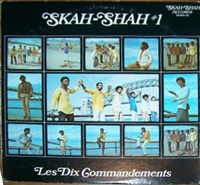
SKAH-SHAH #1
LES DIX COMMANDEMENTS (MARC CD357 1979)
This one is simply gawjus... and though there's no liner notes there is one interesting fact: the sax player, bass, rhythm and lead guitarist and drummer are the same guys I was raving about on the Shleu-Shleu album, so this is another version of the same band. The singer is nicknamed Gubano, suggesting he is influenced by Cuban singers but, other than the occasional shout of "¿Que dice?" it's in French, so I don't get the connection. Skah Shah are veterans of at least 40 albums. The track "Haiti" is familiar, probably a folk song, though it's credited to the drummer, Apollon. Halfway through it kicks up a notch with stereo chorus (or double tracking?) on the sax and a siren to alert you to the big bad world of cops and tonton macoutes outside. Then there's a chorus stolen from a famous tune whose name again eludes me though I can la-la along. Most African sax players (with the obvious exception of J.-S. Essous) can't front a band and play jazz standards with any degree of credibility. Georges Loubert Chancy, however, is not only a fine composer but a good arranger who gives himself room to sparkle and reflect the lustre of the glitterball on his horn. There's an unlisted 11-minute-long ninth track ("Plesi gaye") on which a synth tries to spoil the fun and quotes "Tea for Two" and other Tin Pan Alley chestnuts ("Fairy tales can come true, it could happen to you, if you're young at heart!"). Sound advice.
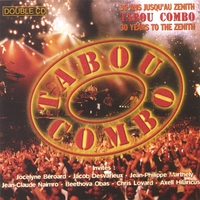
TABOU COMBO
30 YEARS TO THE ZENITH (Sono CDS 7361)
The title means they rehearsed for 30 years before getting this gig, captured live (at their zenith) at the famed Parisian venue in 1998. They invited a bunch of Zouk musicians from Martinique & Guadeloupe to sing and jam with them ensuring that the entire Caribbean populace of Paris and environs would show up in their thousands, so there's a real homecoming party atmosphere which does not detract from the musicianship. (I believe it was also filmed.) Tabou Combo coast through two hours of gold hits including "A kou chou kou chou," "New York City," and "Tabou Mania," all of which appear on the second disc. You may know the refrains, like "Jouc li jou," which they throw in now and then. They rap in English and there's distracting popping bass which dates it a bit but just go with the flow. It bubbles along and does not sound like a stadium, more like a small club, until you hear the dim roar of the huge crowd. Beethova Obas sings "Light is coming your way," a high-energy crowd-pleaser you've danced to if you've ever been in a Caribbean nightclub. He's followed by Jocelyne Beroard, who pours it on for the ballad "Yo." The second set kicks it up a notch with smoking grooves, where you just wanna lose yourself in the ecstasy of a crowded dancefloor. It's palpable in the pulsating 14-minute workout "Bebe Paramount," with Ralph Condé's guitar leads wrapped around the surge of Daniel Pierre's Yamaha DX7. They crank up "New York City," which came out as a maxi-single and is a party starter wherever you find it, and end with another theme song, "Tabou Mania," and its unforgettable chorus about the roof being on fire and the refrain which cannot be quoted in polite company (or played on the radio).
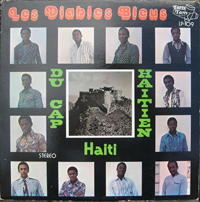
LES DIABLES BLEUS DU CAP HAITIEN
ETOILE LA FILE (Tam Tam LP 109)
Given the choice I will always go for older music in any genre. I don't think I would have got swept up in the soukous vogue of the last century had it not been for my immersion in Congolese rumba. Much as I enjoy the later pop of Haiti -- Sweet Micky, Top Vice and Tabou Combo -- I really dig the "Mini Jazz" bands of the 1970s, when Papa Doc ruled the roost and everyone was united in their struggle against the common enemy: the state. Those are now looked on as the "good old days" because though there was terror in the streets you could still afford a bottle of rum, the Damn Yankees had not killed all the feral pigs, there was plenty of clean water and firewood, and fish in the sea. Haiti is the poorest county in the New World but it was the first independent black nation on earth and the fortress at Cap Haitien played an important role in its liberation struggle. My brother and I attempted to go there in 1998. We were driving around the western Dominican Republic and had the urge to check out Le Cap. It was a Friday night & we were looking for adventure, the Dominican side was pretty tame and we'd just spent the night in a dump breathing diesel fumes, being kept away by idling trucks and active bugs. But we were told we could not take the rental car across the border, so we decided to park it there for a couple of days and walk to Haiti, then catch a bus to the city. A border has to be a secure place to ditch a car, right? A French-speaking character told us our best bet was to pose as missionaries if we wanted to just stroll in there, so we wandered up to the frontier. The Haitian border guard looked as us in our dirty t-shirts and frayed jeans. --Et qui êtes vous? he demanded quizzically. --Nous sommes des missionaires, mon capitaine! I told him assuredly. --And what kind of mission are you on? he enquired, in French. --A musical mission! exclaimed my brother. So that was the end of our first trip to Haiti. Next year we met in the Haitian capital but we never made it to Cap Haitien, though there were folk painters there I dearly wanted to check out. Still you can experience La Citadelle with a sip of rum, some imagination, and this great album by the large ensemble known as the Blue Devils. The leader, Guesly Morriseau, plays (Farfisa?) organ and flute, there are two lead guitars, both very trebly, and a viper saxophonist over a pulsing beat.
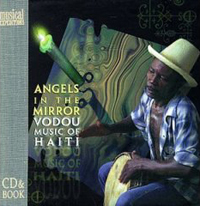
ANGELS IN THE MIRROR
VODOU MUSIC OF HAITI (Ellipsis Arts 4120)
This beautifully packaged 100-page book and CD is a door to the exciting world of Haitian ritual music. Hearing it is like a mini-vacation. It is a quality recording of purely ritualistic drum and chant music, with occasional flute. In Port-au-Prince you must stay at the Olaffson (RAM is the house band), the hotel that is the setting for Graeme Greene's THE COMEDIANS. The action is up Avenue John Brown in the swank suburb of Pétionville, but the Olaffson is an oasis in the heart of Port-au-Prince. When you check in they serve you a complimentary rum cocktail & suddenly everything seems different. The dilapidated pile becomes charming, the bougainvillea is resplendent. The spooky crumbling gothic Victorian mansion is where Charles Addams brought his many wives on their honeymoon, to get fresh inspiration for his cartoons. They sell pricy sequin-embroidered voodoo aprons and bottles in the lobby. Greene stayed here and attended voodoo rituals, as we did, though I went to pee in the bushes, got disoriented and lost, leaving my brother as the sole representative of caucasian curiosity, as I stumbled though the dark streets back to the sanctuary. He turned up after 5 a.m. full of wonder at the music and the possessed people he'd seen. Maya Deren's recordings (which are thinner) are available on MERINGUES AND FOLK BALLADS OF HAITI (Lyrichord LLST 7340); her film DIVINE HORSEMAN is required viewing for those interested in Vodun (as is Zora Neale Hurston's book TELL MY HORSE). The Ellipsis package has great music (dynamically recorded), photos, proverbs, stories, even a recipe for a good luck bath.
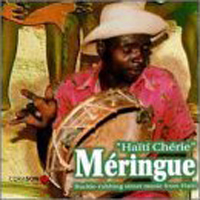
TI BAND L'AVENIR & OTHERS
"HAITI CHERIE" MERINGUE (Corason COCD107)
Issued by the superb Mexican label Corason in 1993, these recordings were made in Haiti in 1983. It's a pure slice of traditional Haitian street music featuring mostly Ti Band l'Avenir. Ti ("Small") bands are ad hoc ensembles of four to six musicians who get together to jam, celebrate or busk for change. If tourists are around they'll do "Haiti cherie" and "Ti zwazo" (literally "Petit oiseau") which is better-known as the calypso "Yellow bird." Subtitled "Buckle-rubbing street music from Haiti," this a a light and happy celebration that is clearly recognizable as the roots of Tabou Combo and the famous Haitian big bands. Of course the Dominicans will tell you they invented merengue and you will also notice parallels to not only calypso but Cuban son as well. The instruments are banjo or six-stringed guitar, a deep lamellophone like a marimba, a conga drum, a drum set with one cymbal, and other percussion which might include a metal guiro, maracas (called Tcha-tcha), and an empty rum bottle hit with a coin to keep the beat. In the 1960s Jean-Baptiste Nemours & Weber Sicot updated the sound and created Compas (also known as Konpa), a style that continues to evolve as synthesizers were added. For a dose of the pure unadulterated sound, this album is a treat.
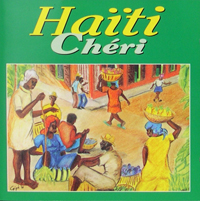
HAITI CHERI (Declic 50403-2)
Here is a completely different album with the same title, from 1985 (It was also the name of an album by pioneer Jean-Baptiste Nemours). This is another up-tempo sampler of hits with Tabou Combo, DP Express, Magnum Band, and all the regulars. It has what at the time was the latest wrinkle, Boukan Ginen, a folkloric troupe with a heavy dance beat. I saw them in concert and they were the rave without overly commercializing their roots sound. They had acoustic guitar and excellent drumming and singing, and also put on an exciting floorshow but I believe they soon broke up. Zshea is another folksinger adding a nice light touch to the proceedings midway through, with what sounds like a banjo lead & a real accordion. A hit from Les Gypsies, "Patience," takes us back to town (Petionville) with warbly flanged guitar and stop-time drumming. Les Gypsies are a personal favourite, along with Les Freres Dejean, another of the old style bands with a large horn section, and Les Diables Bleus from Cap Haitien, as well as Orchestre Septentrionale. Michel Martelly is always reliable and his "Grenadier" coasts along happily, followed by another gem reaching back to the 70s: Coupé Cloué's "Myan Myan." It's not all great but overall an excellent sample of mid-90s Haitian pop.
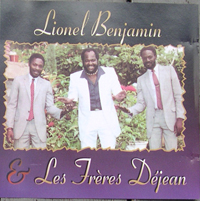
LIONEL BENJAMIN & LES FRERES DEJEAN
(MMI Records CD 1041)
Les Frères Déjean were another of the most popular big old bands, but they regrouped in 1995 and added Lionel Benjamin who reinvigorated their sound. This is an excellent recording, unlike many of the rough recordings of yore. I still seek out Les Gypsies, Shleu Shleu and Les Diables Bleus, where the drumming and bass are to the fore in the mix, the guitars uncommonly speedy. The Gypsies always had titles like "Courage," "Fierté," "Resignation," or "Patience," reflecting the stoicism of the Haitians. Les Frères Déjean got along fine for a long time, after all there were four of them in the band, but this album marked a new departure. Only two brothers remained: Fred on sax and André on trumpet (the rhythm section brothers had gone), and they added a cool singer, Lionel Benjamin. This album has a more pan-Caribbean sound. After Ryco Jazz had brought Congo cool to the Antilles we saw a lot of cross-pollination with artists like arranger/sax player Eddy Gustav & his marvelous Paris productions which added Master Mwana Congo or Rigo Bamundele on guitar to his Antillean lilt. This is a smooth album with more-focussed arrangements. There's a string section on one song. They have the Konpa groove in the pocket and add soukous guitar for a remix of the opening track "Bouké," which is sung in Lingala, and has a strong affinity to the Eddy Gustav Supergroupage sound!
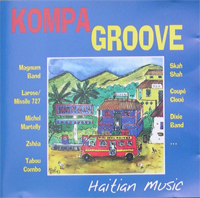
KOMPA GROOVE
LA MEILLEUR DU COMPAS (Caiman distribution 177442)
A good snapshot of 90s Haitian pop (before things really fell apart there) in which the hits keep coming. Skah Shah's "Komparaison" from their "El Cuban'n" album starts the ball rolling and then Sweet Micky (Michel Martelly) gives us "Garage," one of his many late 90s hits. "Homage a Nemours Jean Baptiste" by Tabou Combo moves like a mini-symphony through various rhythms and styles of Konpa. Coupé Cloué's lilting "Sa Ki Pou ou" is also in the mix. Dixie Band's "Cherie" has a truly sick synthesizer lead, but is catchy nonetheless. This set flows well together and while it's not all gold it's a characteristic slice of great upbeat Konpa. The lesser-known acts, like Nestor Azerot, hold their own against the big guns. I found a Haitian webpage which lists the top 100 Kriyo songs of the twentieth century here; it's an interesting list and I am glad to see it agrees with my own opinion.
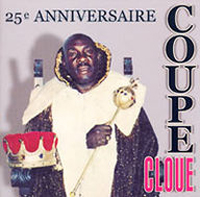
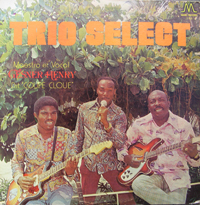
Coupé Cloué
25e ANNIVERSAIRE (CRCD-8017)
Coupé Cloué put out scores of albums. I have two of his earliest LPs with Trio Select, that's them below left, when he was still Gesner Henry. One of first nightclub entertainers to play guitar in Port-au-Prince in the 50s, he picked up on the music sugar-cane cutter bought back from Cuba. His own style of troubadour music with Trio Crystal (renamed Trio Select in 1957) was popularized by their first album in 1960. There's a case to be made for the influence of calypso on Haiti as well as Jamaica, for they start out with "Gros Bamboo" which is "Big Bamboo," a famous calypso (also appropriated in Jamaica).
Coupé Cloué's nickname (meaning "cut and nailed") came from his skill on the soccer pitch, but there's a sexual innuendo there too and he added double entendres to his lyrics, and later, political commentary. The group expanded to become Ensemble Select and toured Ivory Coast in 1975, adding African guitar styling to their sound. Their RACINE album (R. Francis, New York, released 1988) includes a synth but it's chopping rather than wheezing. The opening track "Gaçon Bozo" is brilliant. Great momentum, fine catchy chorus. Too bad it has to end, but the lilting beat kicks up and we are off again. That great track "Gaçon bozo" is also the lead on the ROUGH GUIDE TO HAITI. I don't pay enough attention to follow the lyrics (Kriyo sounds like french so if you understand french you can get a lot of it. It would be great if someone would take the trouble to translate his lyrics and explain the allusions), but there's a sense of time standing style, Coupé raps (he often sings like he's talking) and the band just sits back and percolates. When he's done they chord a few changes and find a resolution, and it seems very relaxed and spontaneous. The 25e ANNIVERSAIRE album (also on CD) has 5 longer tracks, and all of them are choice. "Deux pigeons" has a fine solo guitar (no personnel are listed, but I believe his band stayed with him). "Rose jadin la" is another of his classic songs which has a tune reminiscent of calypso. This 25th Anniversary set ends in a fit of coughing! It's short and sweet.
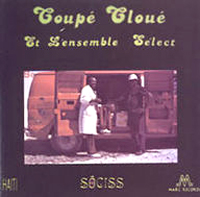
Coupé Cloué ET L'ENSEMBLE SELECT
SOCISS (Mac CD281)
I missed Coupé Cloué's final concert (not billed as such of course) when I was in Haiti in December 1997. My brother and I headed to Jacmel to spend Christmas on the beach in the hideaway town founded by pirates, and on our way back through Cite de Soleil, driving slowly around potholes, garbage in the road, pedestrians and other vehicles including pack animals, we saw the posters for the event, but everywhere there were hand-painted banners announcing gigs by ALL the big bands, many of whom had come down from Florida to entertain their fans at the end of the year. This album has three of my favourite Coupé Cloué tracks on it, but no date or other info. I reckon it is from 1976. There are ten tracks on the CD but apparently only 6 on the LP. Cloué sings in a folkloric style, simple melodies with a trebly guitar, backed by bass and simple percussion, but they always manage to ratchet up a groove and kick into gear. There are certainly parallels to soukous, with the exposition and seben, even an occasional similarity in the guitar which always had a Highlife feel to it. I see Count Reeshard loaded the 12-minute title cut onto his blog for you to grab (I won't tell Marc Duverger, the producer). It's followed by "Pis ta pi triss," another catchy ditty and another favourite, though only 3 minutes long. "Coule Bousson" also stops short but is the other stand-out on this album.
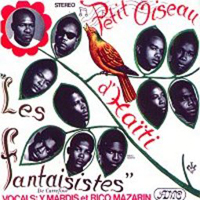
LES FANTAISISTES DE CARREFOUR
PETIT OISEAU (AMC LP 1200)
The modernization of Haitian music was due to two men, Jean-Baptiste Nemours and his bandmate Weber Sicot, whose egos inevitably were too big to share the same stage, but they pointed the way to a new style of music known as "Mini Jazz." Les Shleu Shleu were the first to popularize the new style, among larger bands who were still playing the merengues and sweet old traditional styles that antedated compas. Here is some of that early Mini Jazz from 1968 by a young group led by sprightly soprano sax atop a 4-2-4 rhythm. The liner notes charmingly introduce the band: Byres Besson "Youyou la sympathique," guitar solo who never wants to do two things at the same time; Ferdinand Sydney, "Ti Nemours," guitar accompaniment, of whom it can be said that he has instilled science in the musical field; Carlo Sauvignon, drums, the big gun of the group, who is always ready to reprimand the undisciplined; Gersaint Charles, Pèdè, a busy-body who dreams of outshining everybody; Lionel Lamar, "Teacher," drummer for whom the sticks hold no secret; Yves Mardice, composer, vocalist, with a voice that is warm and which holds you and who is above all the Don Juan of the group.
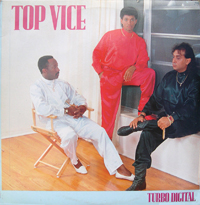
TOP VICE
TURBO DIGITAL (R Francis RFE6505)
This album signaled the shift away from traditional Haitian music to a more pan-Caribbean sound with synthesizers and drum machines in 1990. I must say, at the time, I was totally hooked on it. It fit right in with zouk, the Paris productions of Eddy Gustav, and the Zaiko Langa Langa & Viva la Musica offshoots that were churning out product (& splinter groups) at an alarming rate. R. Francis, the Brooklyn-based label, promoted the new sound in the expatriate communities of Miami (where Top Vice was based-- like Miami Vice, get it?), New York, Toronto, Washington, etc. They added a stop-time, almost hip hop break and lyrics in English to the title track: "Children, children, where did you go? To grand mama's... What did she tell you? Don't bend down! Don't bend down? Don't bend down." Sounds right up there with the true story of Little Red Riding Hood (who had no scarlet cape): after she gets to grandma's house the wolf in disguise tells her to take her clothes off, as she strips he gets her to throw each item on the fire because she won't need it again, and then eats her. The happy ending (she has to take a crap and he lets her go outside tied to a string) was added in the nineteenth century. OK, got a little off the track there, there are some traditional compas tunes, including a Nemours Jn Bp cover, but done in a completely new way. Perhaps a bit dated now, but the keyboard player, Robert Charlo Raymonvil has formidable chops, which were fully exploited on later albums like COMPAS L'AN 2000 and SINFONI DAMOU.
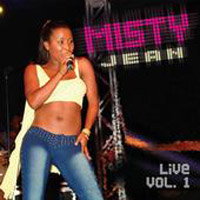
MISTY JEAN
LIVE VOL 1 (Kreyol Music)
Listed as zouk music on various websites but clearly Haitian (correct me if I am wrong) Kompas. At least they are singing in Haitian kreyol. It has the dance-hall feel from Jamaica as told to Sweet Micky, with synths and drum programmes. I don't object to it in Haitian music as that's the nature of their economy: they can't afford to put a big band on stage but a couple of guys with synths and a talented singer can make the scene happen. Misty Jean is definitely an instant party, with or without Babancourt rum. No surprises, just a solid groove, apparently recorded live, that bobs along like a bottle with an intriguing message on the vast rolling ocean. Heavily flanged guitar adds a brittle percussive lead alongside a regular-sounding electric guitar. Thanks to Ken Abrams for turning me onto this. (In return I would like to turn you on to Ken's art.)
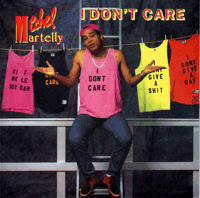
MICHEL MARTELLY
MICHEL MARTELLY LIVE (Exit Entertainment)
Guaranteed to start your party, even if you are on your own. Michel Martelly (aka Sweet Micky) is a one-man band from Haiti. He has put out half a dozen albums and had hits on all of them: "Grenadier," "600 Dola," and "I Don't Care" spring to mind. His lyrics are wry comments on the hardships of life in Haiti, but remind you to forget your troubles and dance. With the death of Coupé Cloué in early 1998 there has been a shift in Haitian popular music away from the dozen-piece ensembles with large horn sections to smaller outfits featuring multi-keyboards, drum machines and bass and guitar. Such are the strictures on musicians in the third world. (I saw one of the "old school" bands in Jacmel in December 1998, and there were more people on the bandstand than in the club.) Martelly is a modest singer and talented keyboard player who loops riffs until he has a thick web of grooves loping along. Then he has a snort of Babancourt rum and half-sings, half-toasts over the wall of sound. Seeing him perform in the Djoumbala nightclub in Pétionville completely changed my attitude about drum machines and synthesizers: the economic restraints of life in the third world require musicians to be resourceful. A compact band with equipment that fits in a taxi is more flexible than the large ensemble that requires a bus. Micky doesn't try to make his keyboards sound like a brass section: they sound like the wheezy mechanical toys they are, with a faint echo of accordion. He yells exhortations -- to you, to himself, and you are caught up in the exhilaration. You're never alone with Micky, he seems to say.
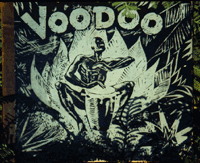
This is the cover to an album of 78s
TABOU COMBO LIVE
Ramada Inn, Berkeley, August 1999
One night, back in the jaded days when I had press access to many clubs, I was checking out Femi Kuti, son of the legendary Nigerian singer Fela Kuti, at Bimbo's 365 Club in North Beach. Femi was promoting his latest album SHOKI SHOKI which has some good hooks and is very well-produced. While Femi is getting the adulation and reaping the benefits of the increased popularity of Afrobeat music, he doesn't have the charisma of his father, who performed like a trapped tiger. Femi's show didn't move me: there was none of the stone juju groove you get with Stephen Osita Osadebe or Sunny Ade. Everything was a bit too frantic, but the crowd enjoyed it. Then I learned that Tabou Combo was playing at the Ramada Inn in Berkeley so quickly made an exit and got to the East Bay before midnight, and before Tabou had finished their first set.
Tabou Combo is a Haitian Konpa group. They had a huge hit in the '70s with "New York City Amelioré." French Caribbean music has long been a bubbling undercurrent on the world music scene. African bands like Sam Mangwana's African All-Stars and, before them, Ryco Jazz, mined the Antillean connection for its laid-back qualities. When it's hot and humid and you've had several glasses of rum you have to approach dancing from the hips and not the ankles.
The Berkeley audience was totally Haitian and completely dressed to kill. The band was informally set up behind stacks of rented Marshall amps and percolating along, appropriately in the dark. A far cry from the Zenith in Paris, scene of their triumphant release: TABOU COMBO: 30 YEARS TO THE ZENITH, but they were still giving it their best shot.
This was not a slick package to push product but some very competent musicians trading riffs and letting the music grow and express itself organically. Very much a show for the folks: the lucky expatriates who had left the grinding poverty but not the soul of Haiti behind them. I recognized "A Kou chou kou chou" but was too conspicuously busy representing that notoriously uncoordinated race on the dance-floor to take notes. At the break I benefited from a fabulous plate of chicken, rice and beans, and platanos. It was so cheap I visited the music table and bought the latest Top Vice CD, COMPAS L'AN 2000 produced in Miami.
Haiti is the poorest country in the New World and the people are stoic, and to all appearances, not unhappy with their plight. Some of them even look nostalgically on the bad old days under Papa Doc because then you at least had a scapegoat, the Tonton Macoutes, and though it was a bloody scary time, it seemed, in retrospect at least, there was a little more to go around. The Haitians don't resent bands who move to Miami -- all the successful ones do -- as long as they come home to perform, and as long as they keep the plight of the people and political topics in their lyrics. For, more than most other contemporary music, Konpa keeps alive the folk tradition of reflecting the true feelings of the people. The most successful versions do it with a groove to move you, so you won't soon forget.